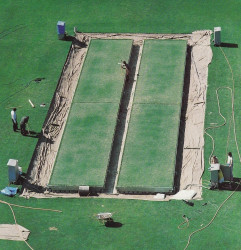In this week’s edition of ‘In Search of West Indies Cricket,’ Roger Seymour reflects on the Legacy of World Series Cricket (WSC). In last week’s Part II of the Packer Revolution, he looked at the man himself, Kerry Packer.
When World Series Cricket (WSC) erupted in May, 1977, cricket was lagging behind the world of professional sport in every facet: administration, players’ compensation, television coverage and sponsorship, among others. Today, aficionados around the world can watch the game in all its formats, whilst enjoying arguably one of the best televised productions in all of sport. WSC’s indelible footprints of innovation and change are everywhere.
$ for cricketers
“[Sir Donald] Bradman had as much to do with the formation of WSC, as Kerry Packer,” Ian Chappell, retired Australian cricket captain and captain of WSC Australian XI.
Chappell had twice attempted to secure increased emoluments for his teammates only to be railroaded by the highly influential Bradman of the Australian Cricket Board (ACB). He was just about to approach union leader Bob Hawke, (later Australian Prime Minister), for advice on the formation of a players’ union when Packer’s substantial offer to play for WSC was presented (a copy of the contract can be seen in Sunday Stabroek, February 7, 2016). Chappelli, as he is affectionately known to the Aussies, was of the firm opinion that the cricket boards around the world operated as a cartel suppressing players’ salaries. With Tony Greig (England captain at the time) and Chappell doing the recruiting, WSC quickly signed 35 of the world’s best players including the entire West Indies team, most of the Australians and the cream of the rest of the world. Sworn to secrecy, not a single player leaked a word; such was the collective feeling of exploitation of the world’s best cricketers.

When the news eventually broke on May 9, 1977, about WSC’s forthcoming season, and the boards were exposed, there was a mad rush to rectify the pittances meted out to the players. England immediately increased their Test match fees from £200 to £1000, without even a ball being bowled. The flood gates had been flung open and the cricketers were now playing and calling the shots.
Today, the upper echelon are multi-millionaires living the good life. India’s M S Dhoni earns US$28.7 million (US$5.7 million in salary and US$23 million in endorsements) to top the list. Virat Kohli also of India is second at US$24.9 million (US$6.9 million and $18 million), followed by T20 hitman Chris Gayle US$7.5 million (US$4.5 million and US$3 million). In the West Indies, annual retainer contracts range from US$100,000 to US$140,000, in addition to match fees. In the recent KFC Big Bash T20 League, the four WI players earned salaries ranging from approximately US$47,300 to US$87,300, for six weeks’ work. At the upper end of the scale, Australia’s annual retainers vary from A$1.5 million to A$250,000, along with Test match fees of A$15,450 (home) and A$21,631 (overseas).
It’s a far cry from the A$300 Test match fees earned by the likes of Chappelli, Lillee, Thommo and Marsh before WSC’s launch.
Portable drop-in cricket pitches
In November, 2015, Shane Warne and Sachin Tendulkar led two teams of retired international Test players including VVS Laxman, Brian Lara, Jacques Kallis, Wasim Akram, Glenn McGrath and Kumar Sangakkara in a three-match T20 series in the USA. The contests were held at the stadiums of the Major League Baseball teams of the New York Mets (Queens, New York, November 7), Houston Astros (Houston, Texas, November 11) and Los Angeles Dodgers (Los Angeles, California, November 14). The only ICC-certified cricket specific ground in the USA is in Lauderhill, Florida. Therefore, games were played on drop-in pitches, which attracted widespread attention. WSC had developed these greenhouse pitches back in 1977. Blocked from the traditional cricket venues by the ACB, Packer hired John Maley, the curator at the Gabba, in Brisbane, Queensland to create pitches for the WSC sites of two Australian Rules Football grounds, a harness racecourse and the Sydney Showground. Maley cultivated the pitches in 25- tonne concrete trays outside the venues. Heavy-duty cranes then lifted and dropped in place his 207-day masterpieces.
At Melbourne Cricket Ground (MCG), site of the 2015 World Cup Final, the ten durable (in use since 2000) drop-in pitches are removed once a year to accommodate Australian Rules Football, rugby, soccer and concerts. StrathAyr Instant Lawn of Australia also has installations at Auckland, Eden Park and Wellington, New Zealand, Adelaide Oval (8 pitches in 2013), South Australia and, most notably, Lord’s Cricket Ground, home of Marylebourne Cricket Club, (MCC), London, England.
Television coverage
The squabble over the exclusive rights to broadcast cricket in Australia is what led to the creation of WSC. Packer owned the Channel 9 TV stations in Sydney, New South Wales (NSW) and Melbourne, Victoria, the two largest metropolises, with nearly 40% of the Australian population. With the advent of colour television in 1975, the TV magnate had sought to boost his stations’ dismal ratings by focusing on sport. An avid sports fan and TV addict, Kerry laid out his own vision for his WSC telecasts.
‘Concept, Preparation, Teamwork,’ was producer David Hill’s motto for ‘the cricket’ as Channel 9 strove for maximum exposure in new territory. A roving production crew of the best cameramen (“the real heroes of the first season,” according to Hill) and technicians from the two cities, were assembled, an unheard of proposition in those days because of the prohibitive cost. Packer insisted on increasing the number of cameras from the norm of five to seven and later, eight. For the first time in history, viewers were provided with coverage from both ends of the ground. “Nobody wants to see a batsman’s bum for half the match,” quipped Packer. Never-before-seen angles, such as side-on to the wicket, were available as cameras were mounted on high vantage points of cranes and lighting towers.
An expert commentary panel of witty and energetic former test players led by the indomitable Richie Benaud helped to interpret the slow motion replays and the slew of on screen graphics and statistics, as opposed to the previous methodology of panning the scoreboard at regular intervals. Microphones in the stumps (in the early 1980s, cameras would be added) and buried around the batting crease, amplified the sounds of willow on leather and at times, unprintable language.
Daddles, a cartoon duck, weeping and dragging his bat, now accompanied batsmen—who had failed to bother the scorers—across the screen as they trundled back to the pavilion. In two seasons, WSC’s production standards for cricket telecasts would reset the bar for the world to emulate.
Advances in digital and computer technology have been quickly adapted to cricket telecasts, with Channel 9 often setting the pace over the last three decades.
These innovations, which have made calling the game fairer and more transparent, include the Snick-O-Meter (1999), Speed Gun (1999), Hawkeye (2001), Helmet-Cams, Umpire/Player Mics (early 2000s), Hot Spot Analysis, High Definition, Hi-Motion Replays (2006), Spider Cam (2010), Zing Wicket System-Flashing Bails (2012), Balls Spin RPM Rev Counter (2013) and Ultra-Cam & StarCam 360 (2013). Today, in the UK, Sky Sports TV utilises the following for a Test match production:
30 cameras on-site, more than 40 microphones, more than 15 miles of cabling, 80 production crew, 15 trucks (including graphics, satellite, storage, catering and security). The state-of-the-art director’s truck with 78 TV screens, comes with a price tag of more than £8 million, making it the most expensive truck in Europe.
“I want the other companies to copy our coverage of cricket,” Packer’s had said to Chappelli in 1977.
Fielding circle/rule changes
The MCC, a pillar of ‘the Establishment’ and copyright owners of the Official Laws of Cricket, would not allow WSC to use its rules of cricket. Benaud had the task of creating the modified rules. With tremendous foresight, he conceptualised specific fielding restrictions for one-day games: nine of the fielding side (including the bowler and wicketkeeper) must be within 25 metres of the bat for the first ten overs of an innings, and six during the remainder.
The modern day ‘circle’ had been born. It was adopted shortly afterwards by the International Cricket Council (ICC) and later modified, along with leg-side field placement restrictions. The Power Play Rules were introduced in 2005. Rule changes before WSC were few and far between, now they are constantly being reviewed and modified. At the 2015 ICC World Cup in Australia and New Zealand, there were eight new adjustments to the rules applied to the 2011 tournament.
Helmets
WSC was heavily promoted as a Gladiator contest. This was going to be the world’s most hostile bowlers against the world’s best batsmen. Bouncers were going to be bowled to tail-enders. Plodders and slow bowlers were not highly sought recruits.
February 24, 1975, 1st Test, New Zealand (NZ) versus England, Auckland, NZ. Debutant Ewen Chatfield, batting at number11, was struck on the head by a Peter Lever bouncer and fell unconscious on the pitch. Chatfield’s heart stopped and he swallowed his tongue. England’s physiotherapist, Bernie Thomas’s quick response saved Chatfield’s life. He regained consciousness 30 minutes later in hospital. (Chatfield represented NZ in another 42 Tests.)
England opening batsman, Dennis Amiss, was on the field at the time, and must have reflected on it, along with the 4-1 Ashes defeat, inflicted by Lillee and Thommo on England, on the first leg of that tour. Amiss was no slouch, he had compiled scores of 262 not out (1974) and 203 (1976) against WI, the latter at the Oval, where Holding had career best returns of 14 wickets for 149. Now as a WSC recruit for the World XI, he would have to confront the world’s most lethal fast bowlers, including, Lillee, Pascoe, Malone (Australia), Roberts, Holding, Garner and Daniel (WI).
“I approached a motorcycle helmet manufacturer and he came up with something lighter than the fibreglass motorcycle helmets around in those days and had a visor that could withstand a shotgun blast from 10 yards,” Amiss told the Telegraph in 2005.
The expected hostility lived up to its hype and WSC poster idol David Hookes had his jaw broken, attempting to hook Andy Roberts, on December 16,1977. It was the tipping point for the helmet. In 1978, Alan Henson of the Australian manufacturer Albion Sports Pty would develop a prototype, popularised by WSC players, which still bears an uncanny resemblance to the modern-day version that every cricketer lugs around in his cricket coffin.
Night cricket
November 28,1978: The first day/night one-day game at a traditional cricket venue, the Sydney Cricket Ground (SCG), was a resounding success. When Packer, who was helping to man the gates, realised that it was going to be a sellout, he threw open the gates. Official attendance was 44,377 with unofficial estimates putting the final number at 52,000. Night cricket was here to stay.
December 8 – 11, 1978: WSC Australian XI versus WSC World XI in the first day/night Supertest at VFL Park, Melbourne. WSC World XI won by 102 runs. Scheduled hours of play were 2.30 pm to 10 pm.
November 27 – 29, 2015: Australia versus New Zealand, in the first day/night Test match, at the Adelaide Oval. Australia won by 3 wickets. Scheduled hours of play were 2.30 pm to 9.30 pm. For the first time ever, a pink ball was used for a Test match.
Coloured clothing
It is a myth that WSC adopted coloured clothing from its inception. In the first season, only the caps and the trims on the sweaters of the players, were coloured. WSC Australia wore gold trim; WSC World XI, duck-egg blue and WSC Windies, coral. It wasn’t until January 17, 1979, at the SCG, in a game between WSC World XI and WSC Australia XI, that full coloured clothing, was worn. ‘Pyjama Cricket’ was the moniker quickly applied to the concept. The ICC would follow suit, in the 1992 World Cup. Today, coloured clothing is standard wear in on- day cricket, all over the world.
White balls
Kookaburra Sports, an Australian company, founded in 1890, began as a harness and saddle maker and turned to the manufacture of cricket balls when it’s livelihood was threatened with the arrival of the motor-car. Since 1946, its Turf cricket ball, has been used exclusively, in Australian, New Zealand and South African Test matches. With WSC plans for night cricket, an alternative was sought to the incumbent red cricket ball, which under yellow floodlights, takes on a brownish colour, very similar to the colour of the pitch. Initially, yellow was considered, before white was chosen. Black sightscreens and pads were selected to provide a contrast for the white ball, to facilitate the batsmen and the umpires.
Kookaburra was given specific instructions by Packer himself, to produce a white ball that would behave exactly like the red ball. This was achieved to a fair degree of success with the one hitch being, that, with play, the white leather deteriorated and lost its colour. WSC adopted the policy of using two balls in a game, one from either end, thus limiting their use to 25 overs each. In 2011, the ICC would embrace this guideline.
Marketing and promotion
Kerry Packer, the TV tycoon, understood the power of corporate sponsorship, marketing and promotion interwoven with a high-quality product, in the medium of television. On the very first day of Season 1 of WSC, the players in their kit, adorned with the WSC logo, were photographed with Ronald McDonald, the renowned mascot of McDonald’s, one of the official corporate sponsors. Motorised water-carts, emblazoned with sponsors’ logos, were introduced. Besides speeding up the game, their attractive lady drivers, precursors to the modern-day T20 cheerleaders, added to the spectacle. Marketing slogans, such as ‘Big Boys Play At Night,’ were printed on products such as t-shirts and a whole new world of merchandising, also directed at children and women was created.
Packer commissioned a jingle to be played along with his WSC ads. “C’mon Aussie C’mon,” written and performed by the Mojo Singers, would spread like an outback wildfire, all across Australia, with all the children singing it. The weeks of February 12 and 19, 1979, saw the jingle hit number 1 on the Australian charts.
The concept of triangular one-day tournaments pioneered by WSC, would become a standard format. Heavily promoted by Packer, the shortened form of the game increased exponentially in popularity and eventually morphed into modern-day T20 leagues.
Professionalism
Packer, always the businessman, brought the whole concept of professionalism to the cricket game.
John Snow, former Sussex, England and WSC fast bowler and genuine rebel, sums it up best, “There were greater demands, in terms of fitness and preparation. Practice was always taken very seriously and we had set training patterns. It was the start of much greater physical demands on cricketers. Previously, fitness was something that was left to you as an individual.”
In June, 2013, Channel 9, would renew its contract with Cricket Australia (CA), to broadcast international cricket, in Australia, between November and February, for the next five years. It was the richest television agreement in the game’s history. The contract was signed for A$450 million in cash and contra advertising. The total value of CA’s broadcast rights now exceeds Aus$1 billion.
The legacy of Channel 9 and Packer lives on.
Trivia question – Who was the last cricket superstar to bat without a helmet?








